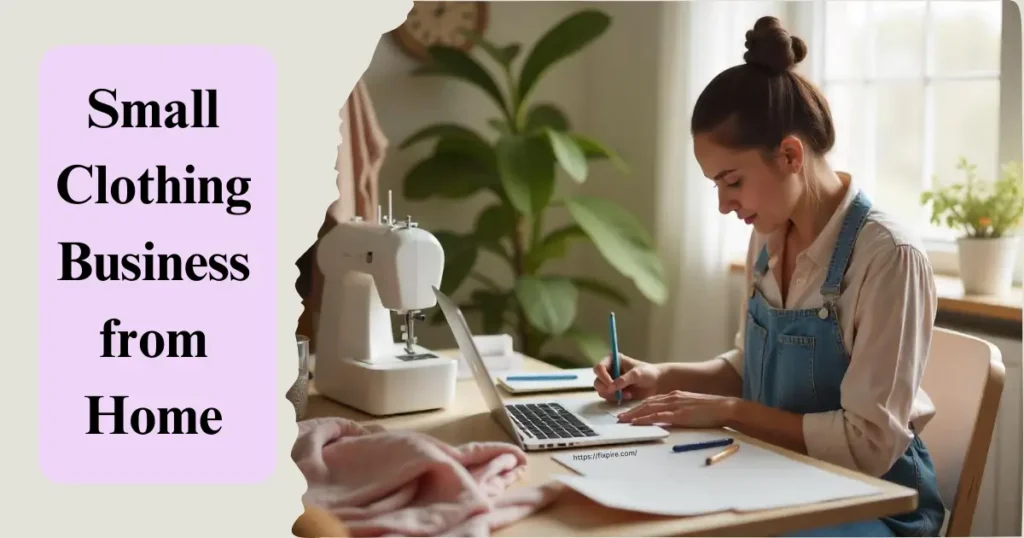Starting a clothing business from home without money might seem impossible, but with the right strategies, it is achievable. How to Start a Small Clothing Business from Home Without Money Easily is a question many aspiring entrepreneurs ask, and the good news is—it’s possible. If you are passionate about fashion and ready to put in the effort, you can launch a profitable home-based clothing business without upfront costs. This guide will walk you through the process step by step, ensuring that you start your small clothing business startup successfully.

Why Start a Clothing Business from Home?
A home-based clothing business offers flexibility, low overhead costs, and the ability to work at your own pace. With the rise of social media and e-commerce platforms, selling clothes from home has never been easier. You don’t need a physical store or a massive budget to get started. Instead, creativity and resourcefulness can help you launch and grow your brand.
Benefits of a Home-Based Clothing Business
- Low startup costs: No need to rent a store or invest heavily in inventory.
- Flexible working hours: Work on your schedule, balancing business and personal life.
- Global reach: Sell to customers beyond your local area using online platforms.
- Creative freedom: Design and sell clothing that matches your style and vision.
- Potential for passive income: Utilize print-on-demand and dropshipping to generate sales with minimal ongoing effort.
- Easy scalability: Start small and expand as demand increases.
How to Start a Small Clothing Business from Home Without Money

Step 1: Choose Your Niche
Before you start a clothing business from home, it is crucial to decide on a niche. The fashion industry is vast, and identifying a specific market will help you stand out. Consider these popular niches:
Popular Clothing Niches
- Handmade clothing – Custom-made dresses, shirts, or accessories.
- Print-on-demand – T-shirts, hoodies, and caps with unique designs.
- Thrift and vintage – Selling second-hand clothes with a curated style.
- Kidswear – A profitable niche focusing on children’s clothing.
- Activewear – Gym outfits, yoga pants, and sportswear.
- Sustainable fashion – Eco-friendly and recycled material clothing.
- Streetwear – Trendy, casual fashion for younger audiences.
- Luxury resale – Selling pre-owned high-end designer brands.
Choosing a niche will allow you to target the right audience and build a strong brand identity. Research trending styles, analyze competitors, and identify gaps in the market.
How to Identify the Right Niche
- Conduct market research to understand customer needs.
- Use social media platforms to identify trending fashion styles.
- Identify a niche that matches your passion and expertise.
- Check competitors and see what is working for them.
- Consider profitability and demand trends over time.
Step 2: Create a Business Plan
A clothing business plan for beginners should outline your goals, target market, business model, and marketing strategies. Your business plan can be simple and straightforward. Instead, focus on these essential elements:
Key Elements of a Clothing Business Plan
- Business name and brand identity: Choose a unique, memorable name.
- Target audience: Research your ideal customers’ preferences.
- Sourcing products: Decide how you will obtain your clothing items.
- Pricing strategy: Set competitive prices while ensuring a profit.
- Marketing plan: Define your strategy for promoting your business.
- Financial projections: Plan how to reinvest and scale your business.
- Revenue model: Decide whether you will use dropshipping, print-on-demand, or direct sales.
Consider using free business plan templates available online to help structure your plan effectively.
Step 3: Find Free or Low-Cost Clothing Suppliers
Starting without money means you need to be resourceful in sourcing your products. Here are some ways to get inventory for free or at a minimal cost:
How to Source Clothing for Free
- Sell from your wardrobe – Begin by selling clothes you no longer wear.
- Partner with friends and family – Ask them to donate or consign clothes to you.
- Join online giveaways and contests – Many brands give away free items.
- Thrift flipping – Source cheap clothes from thrift stores and upcycle them.
- Swap events – Attend clothing swap events to acquire new pieces for free.
Finding Low-Cost Suppliers
- Dropshipping – You don’t need inventory; suppliers ship directly to customers.
- Print-on-demand services – No upfront cost; you earn a commission per sale.
- Wholesale partnerships – Some suppliers offer inventory on consignment.
- Local manufacturers – Some small suppliers allow you to pay later.
- Bulk purchasing from clearance sales – Retailers often sell overstock at a discount.
Step 4: Set Up Your Online Store for Free
Selling online is the easiest way to reach customers. Thankfully, many platforms allow you to set up a store for free. Here are your best options:
Best Free Online Selling Platforms
- Facebook Marketplace – Sell directly to local buyers.
- Instagram and TikTok Shops – Perfect for visual branding and sales.
- Etsy – Great for handmade and vintage clothing.
- Shopify (Free Trial) – Start selling with no upfront costs.
- Depop & Poshmark – Ideal for thrift and trendy fashion sellers.
- eBay – A great place to sell both new and used clothing.
- Your own website – Use platforms like Wix or WordPress to create a free store.
Step 5: Market Your Home-Based Clothing Business
Marketing plays a crucial role in growing your business. Here’s how to promote your clothing business for free:
Free Marketing Strategies
- Leverage social media – Post engaging content, use trending hashtags, and interact with potential customers.
- Create a blog or YouTube channel – Share styling tips, fashion trends, or behind-the-scenes content.
- Offer referral incentives – Encourage customers to refer friends in exchange for discounts.
- Join Facebook groups and online forums – Promote your business in relevant communities.
- Use influencer collaborations – Partner with micro-influencers for exposure.
- Email marketing – Build a list and send offers or new arrivals.
- Run contests and giveaways – Encourage engagement and brand awareness.
Step 6: Offer Excellent Customer Service
Building a loyal customer base is key to long-term success. Provide excellent customer service by:
Responding promptly to inquiries
- Ensuring quality packaging and shipping
- Offering hassle-free returns (if applicable)
- Asking for customer reviews and testimonials
- Providing personalized shopping experiences
Step 7: Scale Your Business Over Time
Once your business starts generating income, reinvest your profits to expand. Here’s how you can scale:
Ways to Grow Your Clothing Business
- Upgrade your website – Invest in a professional-looking e-commerce store.
- Run paid ads – Use Facebook and Instagram ads to reach a wider audience.
- Expand your product line – Introduce new clothing categories.
- Collaborate with designers – Create exclusive designs to stand out.
- Hire freelancers – Get help with social media, photography, or customer service.
Conclusion
Starting a small clothing business from home without money is absolutely possible with determination, creativity, and strategic planning. By leveraging free resources, utilizing social media, and providing excellent customer service, you can build a successful fashion brand from scratch. Follow these steps, stay consistent, and watch your home-based clothing business thrive!











